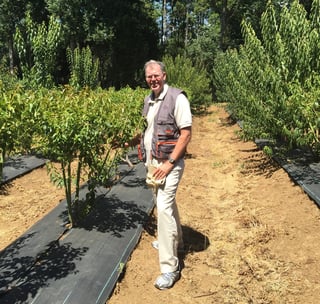Dr. Sears was doing his best Indiana Jones imitation when he recently went to the Patagonia region of Chile to inspect progress in domesticating the wild maqui berry.
The Chilean government and other private Chilean partners have spent millions of dollars over the past five years to study the genetics of the maqui berry that grows wild in this area of Chile. Starting with more than 1,500 different clones of the wild maqui berry, they chose the “best of the best” for domestication. Now for the first time their research results are beginning to bear fruit (pardon the pun).
Here you can see our intrepid Indiana Jones (without his bullwhip) standing next to a two-year old domesticated maqui berry bush that has been bred for the right height for harvesting. The difficulty of this project was even greater since the maqui berry bush changes sex every two years. That’s why it takes five years for a bush to reach full maturity. In addition, the test field was chosen to induce the maximum stress to the plant (high winds, decreased ozone layer, cold temperatures at night) to maximize the polyphenol content of the maqui berry.
It is this commitment to domesticating the wild maqui berry that confirms Dr. Sears’ contention that the isolated polyphenols as found in MaquiRx™ will be the “best of the best” when it comes to polyphenol extracts. The ongoing clinical research confirms that conviction, especially with new studies demonstrating the superiority of the purified maqui berry polyphenol extract in slowing down the aging process by activation of the SIRT-1 gene.







Let Us Know What You Thought about this Post.
Put your Comment Below.